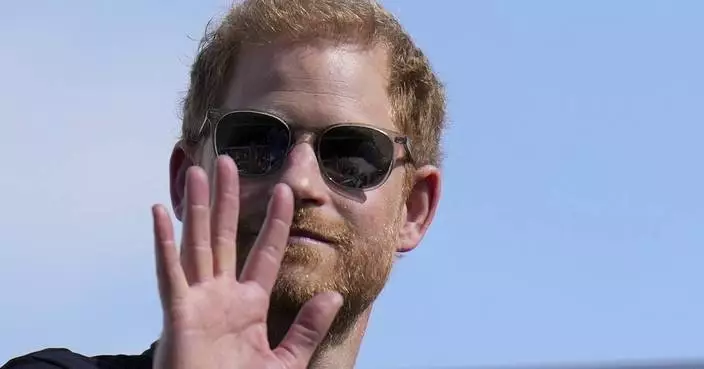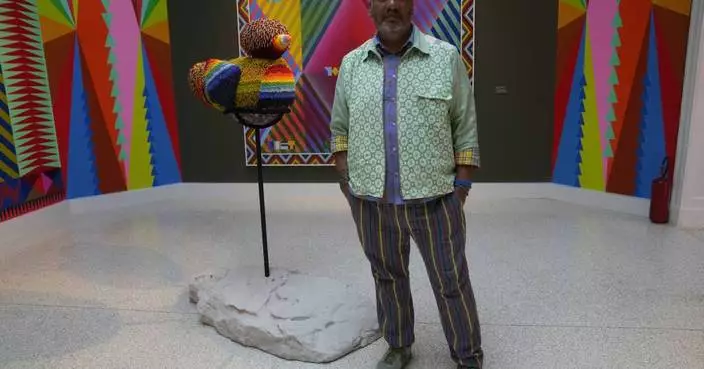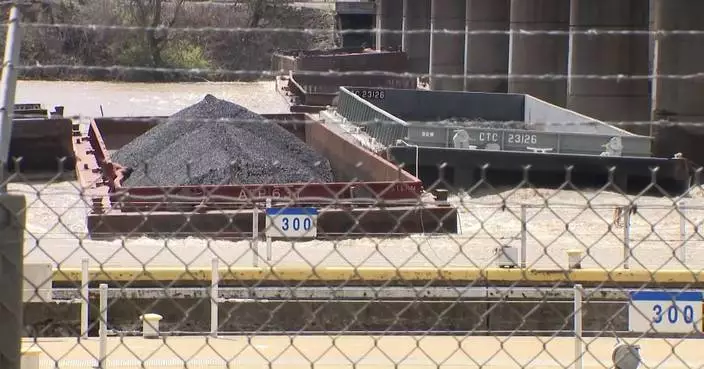Before Chuck Boers joined the U.S. Army, the Lipan Apache member was given his family's eagle feathers. The feathers had been carried by his great-great-great-grandfather on his rifle when he was an Apache scout.
They also were carried by relatives who fought in World War I, World War II, Korea and Vietnam. In 2004, Boers had the feathers with him during the Battle of Fallujah in Iraq. "I felt like I had my family with me to protect me," he said.
Click to Gallery
Before Chuck Boers joined the U.S. Army, the Lipan Apache member was given his family's eagle feathers. The feathers had been carried by his great-great-great-grandfather on his rifle when he was an Apache scout.
The documentary exhibits the mixed feelings some Native Americans felt toward the U.S. military and how tribal members embraced those who served as "warriors."
At the onset of World War I, the first generation of Native Americans after the so-called Indian Wars began joining the U.S. Army even though they weren't considered citizens or allowed to vote. Returning veterans, and also those from World War II, earned accolades for their service. For example, Comanche and Navajo Code Talkers in World War II were credited with passing secrets amid hostile fighting.
"Many have waited a long time to talk about this," Hott said. "One veteran told me he hadn't even told his wife about his experiences."
He'd fight a year in Vietnam. Before he left, his grandmother prayed over him in the Kiowa language and placed medicine on him. "A couple of times in Vietnam, I could have gotten killed. Was it luck?" Asepermy said. "I think it was because of the prayers my grandmother gave me."
"The Warrior Tradition," a new film set to air on PBS, examines the complex history of Native Americans in the U.S. military since World War I and how their service transformed the lives for Native Americans from various tribes. Through interviews with veterans and using archival footage, the documentary probes the complicated relationship Native Americans had with military service and how they used it to press for civil rights.
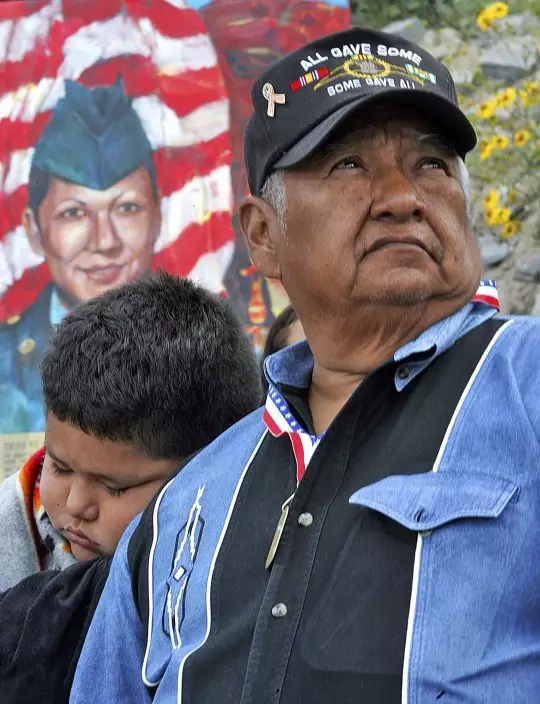
FILE - In this March 23, 2005, file photo, a portrait of U.S. Army Spc. Lori Piestewa, is shown behind her father, Terry Piestewa, right, and her son, Brandon Piestewa, at a sunrise ceremony in Phoenix. Lori Piestewa, a member of the Hopi Tribe and a single mother of two, is believed to be the first American Indian woman killed while fighting for the U.S. military. "The Warrior Tradition," a new film set to air on most PBS stations Monday, Nov. 11, 2019, examines the history of Native Americans in the U.S. military since World War I. (AP PhotoMatt York)
The documentary exhibits the mixed feelings some Native Americans felt toward the U.S. military and how tribal members embraced those who served as "warriors."
"From just about the beginning of the United States itself, the government has fought various wars against Native nations. And that's the irony," Patty Loew, director of the Center for Native American and Indigenous Research at Northwestern University, said in the film.
But Native Americans, from tribes in Oklahoma to nations in Washington, joined the U.S. military to honor their "end of the treaty" that the U.S. government previously broke, Loew said.

FILE - In this June 15, 2012, file photo, Jerry Best, a Vietnam War veteran of the Cheyenne tribe, dances on during a Native American blessing for veteran and active-duty servicemen in Camp Pendleton, Calif. "The Warrior Tradition," a new film set to air on most PBS stations Monday, Nov. 11, 2019, examines the history of Native Americans in the U.S. military since World War I. (AP PhotoGregory Bull, File)
At the onset of World War I, the first generation of Native Americans after the so-called Indian Wars began joining the U.S. Army even though they weren't considered citizens or allowed to vote. Returning veterans, and also those from World War II, earned accolades for their service. For example, Comanche and Navajo Code Talkers in World War II were credited with passing secrets amid hostile fighting.
The returning veterans began demanding the right to vote and fought against discrimination. For example, Miguel Trujillo Sr., a Marine sergeant in World War II and a member of Isleta Pueblo in New Mexico, returned and waged a legal battle to overturn that state's law that barred American Indians living on reservations from participating in elections.
Director Larry Hott said the veterans in the film believed military service was part of their family history and wasn't just about a way to escape poverty. It's part of a legacy that goes back generations, he said.

FILE - In this June 15, 2012, file photo, Navy Hospital Corpsman Third Class Kevin Zotigh, of the Kiowa tribe, performs a ceremonial dance as part of a Native American blessing for veteran and active-duty servicemen in Camp Pendleton, Calif. "The Warrior Tradition," a new film set to air on most PBS stations Monday, Nov. 11, 2019, examines the history of Native Americans in the U.S. military since World War I. (AP PhotoGregory Bull, File)
"Many have waited a long time to talk about this," Hott said. "One veteran told me he hadn't even told his wife about his experiences."
Retired Army Sgt. Maj. Lanny Asepermy, who is Comanche and Kiowa, said after the Comanches surrendered to the U.S. in 1875, the tribe's warrior tradition was hurt. Then some Comanche joined World War I.
"We became warriors again," Asepermy said. He grew up seeing photos of relatives in the military at his grandparents' home. "I've always wanted to be a soldier. I didn't want to be anything else."

In this June 15, 2012, file photo, Blas Preciado, left, a Vietnam War veteran of the Kiowa tribe, talks with Marine Cpl. Frank Tartsah, right, also of the Kiowa tribe, during a Native American blessing for veteran and active-duty servicemen in Camp Pendleton, Calif. "The Warrior Tradition," a new film set to air on most PBS stations Monday, Nov. 11, 2019, examines the history of Native Americans in the U.S. military since World War I. (AP PhotoGregory Bull, File)
He'd fight a year in Vietnam. Before he left, his grandmother prayed over him in the Kiowa language and placed medicine on him. "A couple of times in Vietnam, I could have gotten killed. Was it luck?" Asepermy said. "I think it was because of the prayers my grandmother gave me."
The one-hour documentary co-produced by WNED-TV Buffalo Toronto and Florentine Films/Hott Productions, Inc., is scheduled to air on most PBS stations on Monday.
Russell Contreras is a member of The Associated Press' race and ethnicity team. Follow him on Twitter at: http://twitter.com/russcontreras
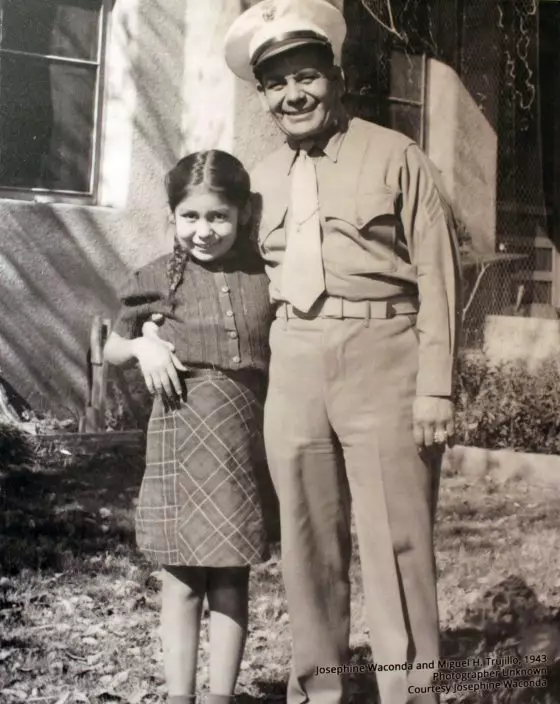
FILE - This March 9, 2012, file photo, shows a photograph of Miguel Trujillo of Isleta Pueblo, N.M., and his daughter on display for an exhibit at the Indian Pueblo Cultural Center in Albuquerque, N.M. Trujillo fought in 1948 for the right of American Indians to vote in New Mexico after serving in World War II. "The Warrior Tradition," a new film set to air on most PBS stations Monday, Nov. 11, 2019, examines the history of Native Americans in the U.S. military since World War I. (Indian Pueblo Cultural Center via AP, File)
UNITED NATIONS (AP) — The United States vetoed a widely backed U.N. resolution on Thursday that would have paved the way for full United Nations membership for Palestine, a goal the Palestinians have long sought.
The vote in the 15-member Security Council was 12 in favor, the United States opposed and two abstentions, from the United Kingdom and Switzerland. U.S. allies France, Japan and South Korea supported the resolution.
The resolution would have recommended that the 193-member General Assembly, where there are no vetoes, approve Palestine becoming the 194th member of the United Nations. Some 140 countries have already recognized Palestine, so its admission would have been approved, likely by a much higher number of countries.
U.S. deputy ambassador Robert Wood told the council the U.S. veto “does not reflect opposition to Palestinian statehood, but instead is an acknowledgment that it will only come from direct negotiations between the parties."
Before the vote, U.S. deputy State Department spokesman Vedant Patel said the United States has “been very clear consistently that premature actions in New York — even with the best intentions — will not achieve statehood for the Palestinian people.”
This is the second Palestinian attempt for full membership and it comes as the war in Gaza has put the more than 75-year-old Israeli-Palestinian conflict at center stage.
Palestinian President Mahmoud Abbas first delivered the Palestinian Authority’s application for U.N. membership in 2011. That bid failed because the Palestinians didn’t get the required minimum support of nine of the Security Council’s 15 members.
The Palestinians then went to the General Assembly, and by more than a two-thirds majority succeeded in having their status raised from a U.N. observer to a non-member observer state in November 2012. That opened the door for the Palestinian territories to join U.N. and other international organizations, including the International Criminal Court.
The strong support the Palestinians received Thursday reflects not only the growing number of countries recognizing their statehood but almost certainly the widespread global support for Palestinians caught in the war in Gaza, now in its seventh month.
Algeria’s U.N. Ambassador Amar Bendjama, the Arab representative on the council who introduced the resolution, called Palestine’s admission “a critical step toward rectifying a longstanding injustice" and said that “Peace will come from Palestine’s inclusion, not from its exclusion.”
In explaining the U.S. veto, Wood said there are “unresolved questions” on whether Palestine meets the criteria to be considered a state. He pointed to Hamas still exerting power and influence in the Gaza Strip, which is a key part of the state envisioned by the Palestinians.
Wood stressed the U.S. commitment to a two-state solution where Israel and Palestine live side-by-side in peace as the only path for both sides to live with security and for Israel to establish relations with all its Arab neighbors, including Saudi Arabia.
“The United States is committed to intensifying its engagement with the Palestinians and the rest of the region, not only to address the current crisis in Gaza, but to advance a political settlement that will create a path to Palestinian statehood and membership in the United Nations,” he said.
Ziad Abu Amr, special representative of the Palestinian president, said adopting the resolution would grant the Palestinian people hope “for a decent life within an independent state.”
He stressed to the Security Council that it wouldn't be an alternative “for serious negotiations that are time-bound to implement the two-state solution” and U.N. resolutions, and to resolve pending issues between Palestinians and Israelis.
“To grant the state of Palestine full membership will be an important pillar to achieve peace in our region, because the Palestinian-Israeli conflict and its different dimensions now goes beyond the borders of Palestine and Israel and impacts other regions in the Middle East and around the world,” the Palestinian envoy said before the vote.
Israeli-Palestinian negotiations have been stalled for years, and Israel’s right-wing government is dominated by hard-liners who oppose Palestinian statehood.
Israeli U.N. Ambassador Gilad Erdan called the resolution “disconnected to the reality on the ground” and warned that it “will cause only destruction for years to come and harm any chance for future dialogue.”
Six months after the Oct. 7 attack by Hamas, which controlled Gaza, and the killing of 1,200 people in “the most brutal massacre of Jews since the Holocaust,” he accused the Security Council of seeking “to reward the perpetrators of these atrocities with statehood.”
Israel’s military offensive in response has killed over 32,000 Palestinians, according to Gaza’s health ministry, and destroyed much of the territory.
Erdan listed the requirements for U.N. membership — accepting the obligations in the U.N. Charter and especially being a “peace-loving” state.
“What a joke,” he said. “Does anyone doubt that the Palestinians failed to meet these criteria? Did anyone hear any Palestinian leader even condemn the massacre of our children?”

Representatives of member countries take votes during a Security Council meeting at United Nations headquarters, Thursday, April 18, 2024. (AP Photo/Yuki Iwamura)
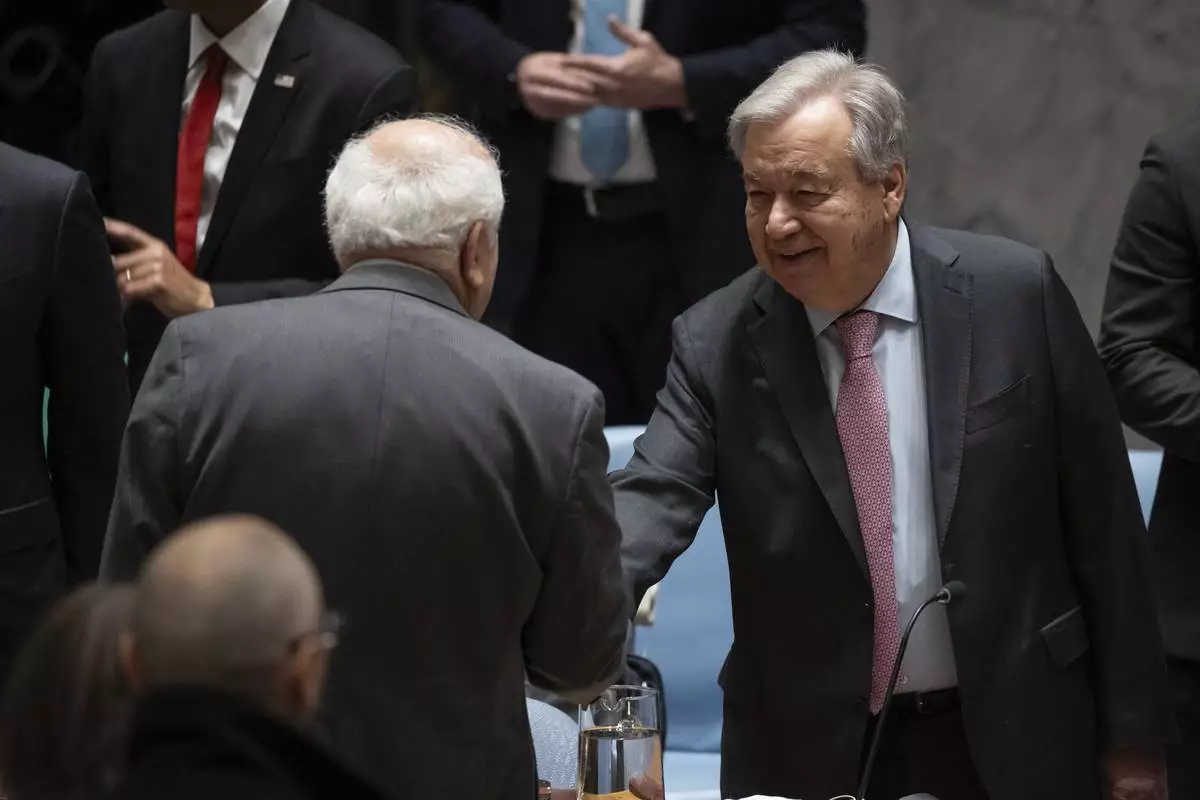
Palestinian Ambassador to the United Nations Riyad Mansour, left, and United Nations Secretary-General Antonio Guterres speak before a Security Council meeting at the United Nations headquarters, Thursday, April 18, 2024. (AP Photo/Yuki Iwamura)
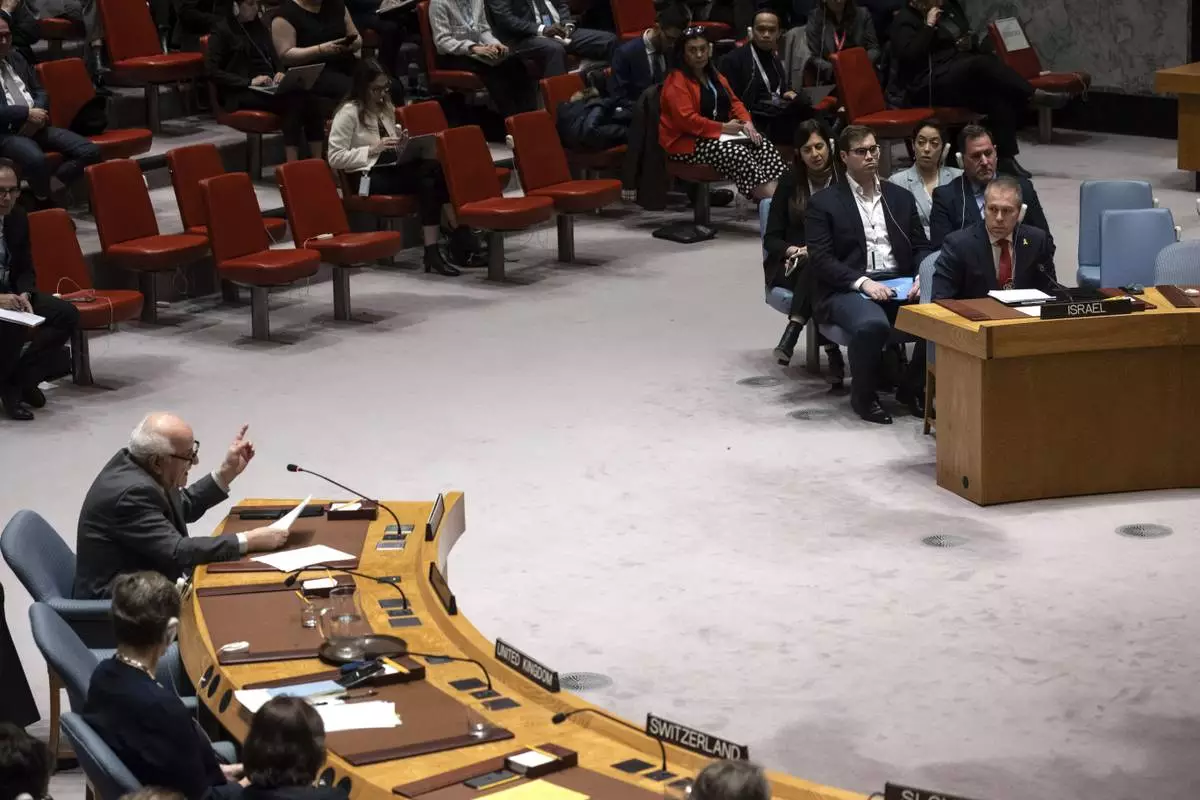
Palestinian Ambassador to the United Nations Riyad Mansour speaks during a Security Council meeting at United Nations headquarters, Thursday, April 18, 2024. (AP Photo/Yuki Iwamura)

Representatives of member countries take votes during a Security Council meeting at United Nations headquarters, Thursday, April 18, 2024. (AP Photo/Yuki Iwamura)

Israeli Ambassador to the United Nations Gilad Erdan speaks during a Security Council meeting at United Nations headquarters, Thursday, April 18, 2024. (AP Photo/Yuki Iwamura)
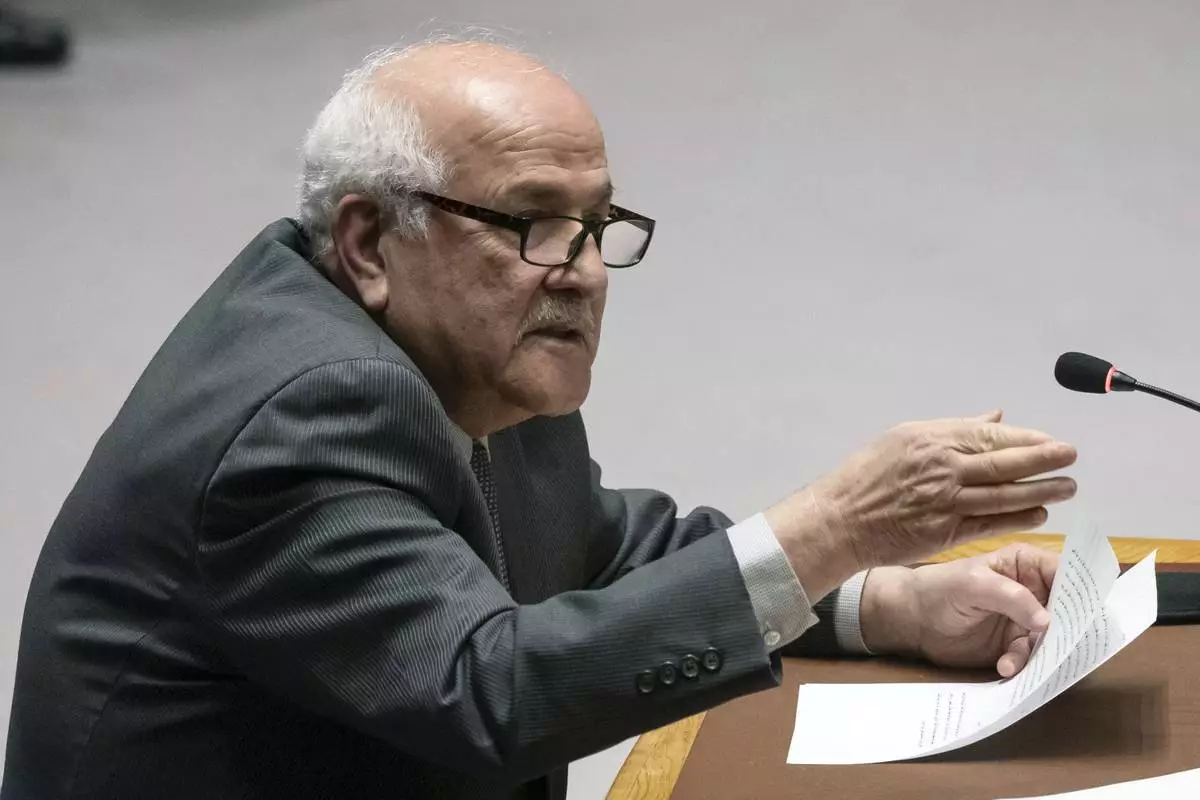
Palestinian Ambassador to the United Nations Riyad Mansour speaks during a Security Council meeting at United Nations headquarters, Thursday, April 18, 2024. (AP Photo/Yuki Iwamura)
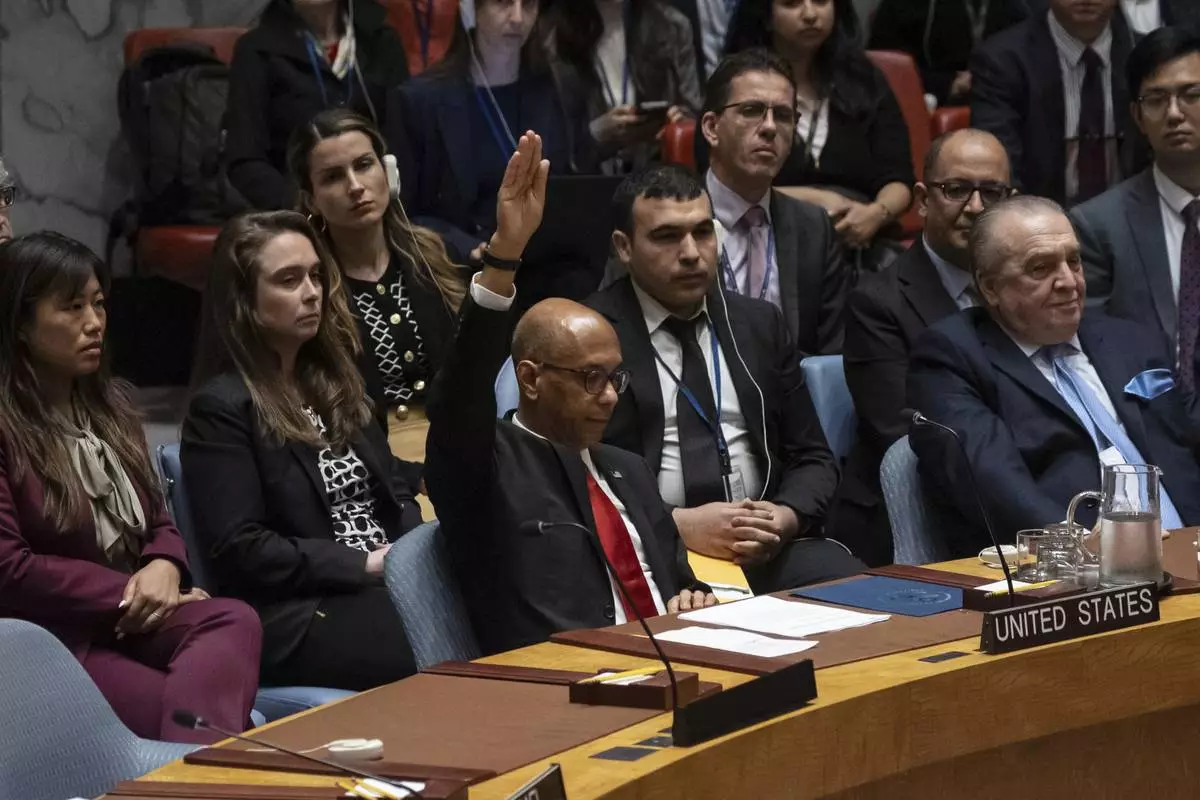
U.S. Deputy Ambassador Robert Wood votes against resolution during a Security Council meeting at United Nations headquarters, Thursday, April 18, 2024. (AP Photo/Yuki Iwamura)
















